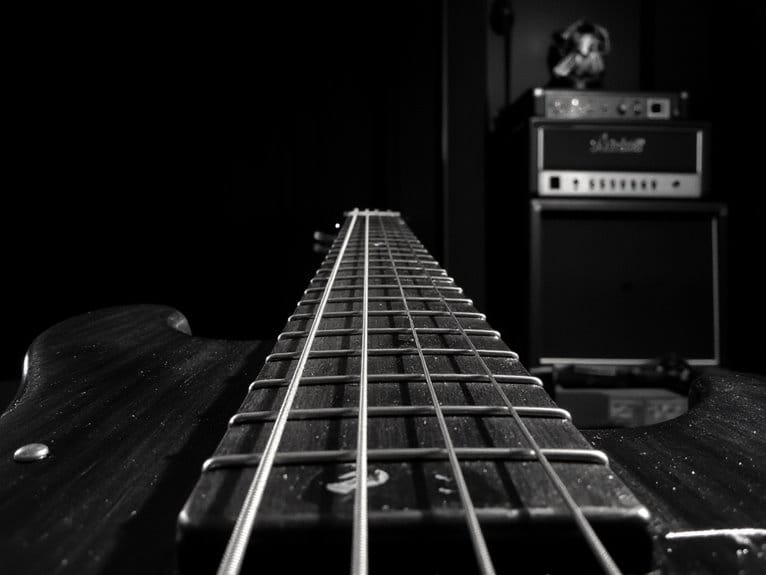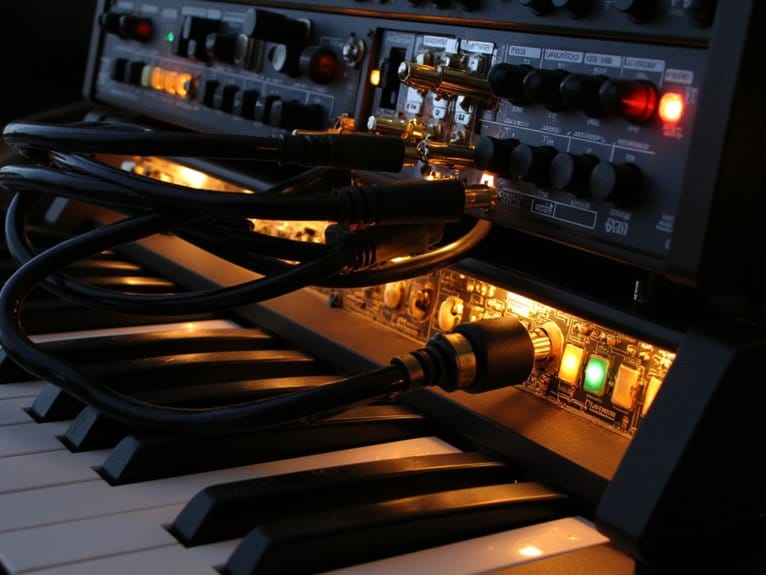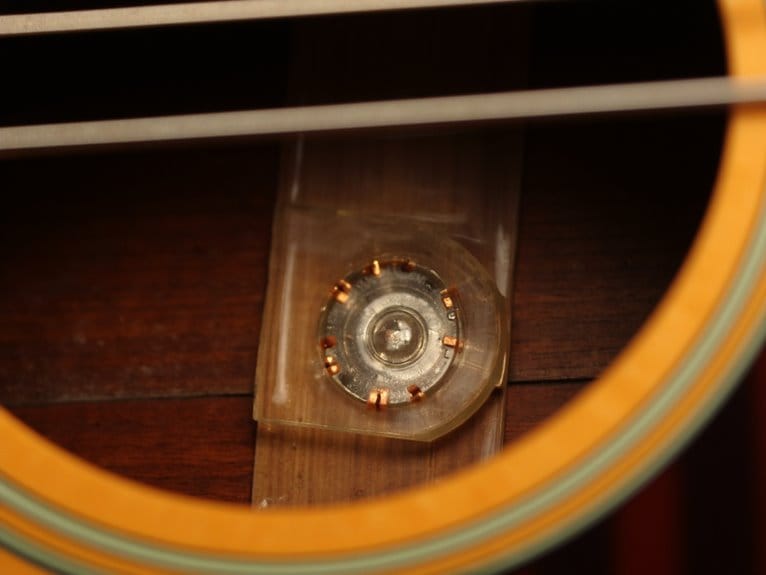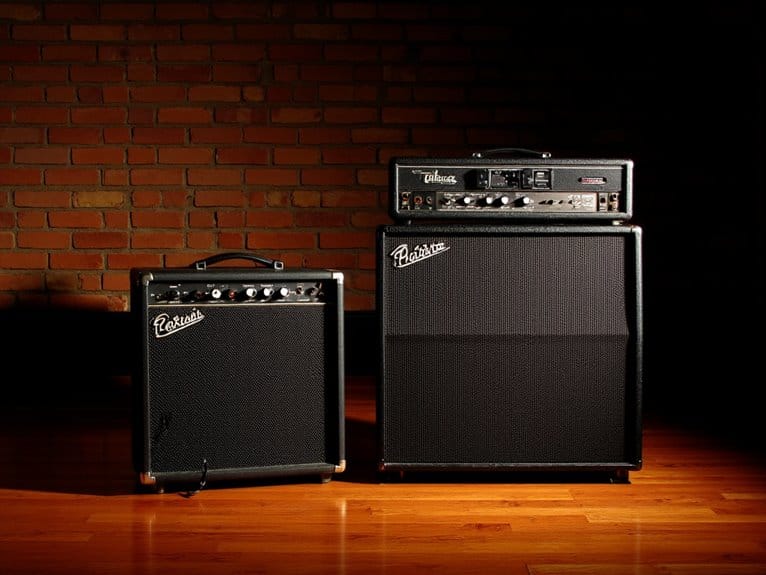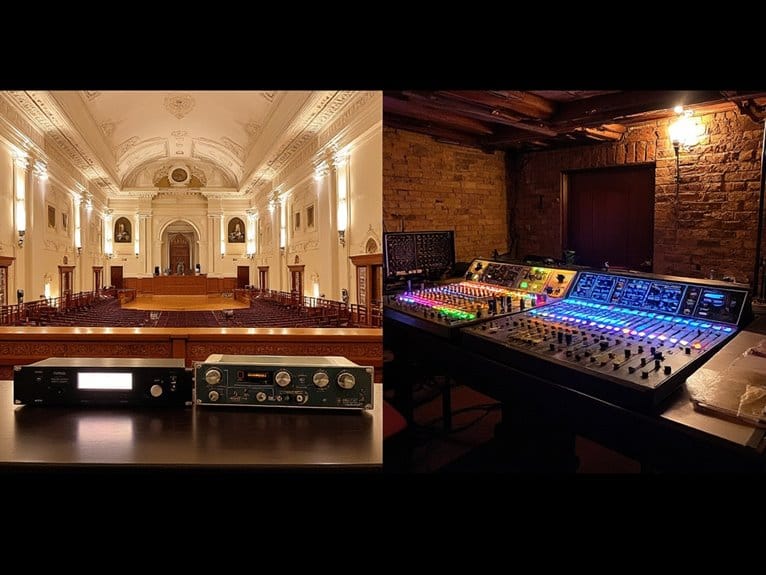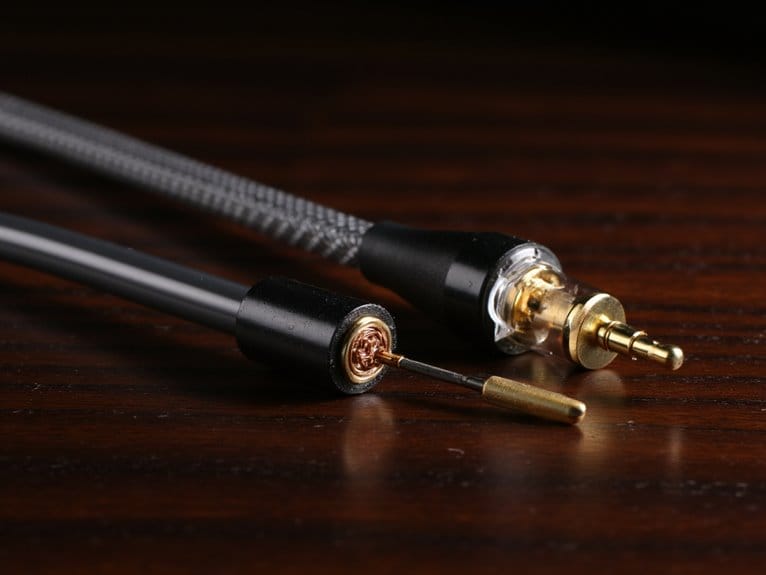Metal Bass: Clarity in Heavy Mix
You’ll achieve metal bass clarity by surgically cutting frequencies below 100 Hz while preserving the 120-200 Hz range for fullness, then boosting 400-600 Hz for punch through dense mixes. Apply aggressive compression ratios of 5:1 to 10:1 with 100ms attack times to maintain pick clarity, and use sidechain compression triggered by kick transients to create separation. Parallel saturation chains add harmonic content without muddiness, while strategic frequency positioning keeps your low-end defined against wall-of-sound arrangements that would otherwise swallow your presence completely.
We are supported by our audience. When you purchase through links on our site, we may earn an affiliate commission, at no extra cost for you. Learn more.
Notable Insights
- Apply aggressive compression with 5:1 to 10:1 ratios and 100ms attack times to preserve initial strike while controlling dynamics.
- Cut frequencies below 100 Hz surgically and boost 400-600 Hz range for punch that cuts through dense guitar layers.
- Use sidechain compression triggered by kick drum with fast attack/release times to create separation between low-end elements.
- Implement parallel saturation chains with high-pass filtering to add harmonic content without increasing muddiness in the mix.
- Target 1-3 kHz frequency range for pick attack clarity while using multiband compression for precise frequency control.
Essential Techniques for Sharp Bass Attack and Presence
When you’re working with metal bass in a heavy mix, achieving that sharp, cutting attack while maintaining consistent presence requires a strategic combination of compression, EQ sculpting, and harmonic enhancement techniques that I’ve refined over years of mixing dense, guitar-heavy productions.
Start with aggressive compression ratios around 5:1 to 10:1, which effectively squashes the dynamic range while preserving that punchy character you need. For transient shaping, I typically set attack times around 100ms to maintain the initial strike without completely flattening it, paired with fast release times that quickly restore energy between notes.
Adding subtle harmonic distortion in parallel helps the bass cut through without muddying the low end, while careful EQ work around 450Hz prevents that boxy sound that can kill your mix’s clarity. Professional bass preamp pedals with built-in noise gates can further enhance your signal’s clarity by eliminating unwanted artifacts that compete with your attack transients. When recording direct, a quality DI box with proper ground loop elimination ensures your signal remains clean and interference-free before any processing takes place. To further tighten your low-end response, incorporating a bass compressor pedal can help maintain even dynamics while preserving the character of your tone. This allows for a consistent and polished sound, making it easier for the bass to blend seamlessly with other instruments in the mix. Additionally, experimenting with the attack and release settings can yield different levels of sustain and punch, giving you more control over how your bass sits in the overall arrangement.
Critical Frequency Management for Metal Bass Definition
Understanding how each frequency band affects your metal bass tone becomes absolutely essential once you’re dealing with the complex spectral competition that defines heavy music production.
Mastering frequency balance separates amateur bass recordings from professional metal productions that cut through dense instrumental arrangements.
I’ve learned that surgical cuts around sub-100 Hz eliminate boominess while preserving the critical 120-200 Hz body that gives your bass fullness, though this range can conflict with kick drums if you’re not careful.
The 400-600 Hz zone adds punch through dense guitar layers, while 600 Hz to 1.2 kHz delivers that aggressive growl character.
Your pick attack lives in the 1-3 kHz range, requiring dynamic frequency modulation to maintain clarity without harshness.
Achieving proper tonal balance means understanding that each frequency decision affects how your bass coexists with other instruments in the mix.
Compression Strategies for Dynamic Control in Dense Mixes
Metal bass compression demands aggressive control strategies that go far beyond the gentle limiting you’d apply to cleaner genres. This requires precise threshold and ratio settings that can handle the explosive dynamics of distorted low-end without crushing the life out of your performance.
Your compression settings need deliberate aggression, with ratios from 4:1 to 10:1 creating the consistent punch that cuts through wall-of-sound arrangements. Attack timing below 10ms clamps transients immediately, while release timing matches your track’s tempo to preserve natural sustain between notes. Understanding that the attack of notes often falls between 700 to 1200 Hz helps optimize your compressor response for maximum clarity.
- Parallel blending maintains dynamics by mixing heavily compressed duplicates under your dry signal
- Sidechain dynamics use kick drum triggers to create low-end separation automatically
- Frequency targeting with multiband compression isolates problematic ranges without affecting articulation
- Threshold adjustment achieves 5-20dB gain reduction for ideal tightness without pumping artifacts
Creating Space Between Bass and Kick Drum Elements
Since kick drums and bass guitars naturally compete for the same sonic real estate in metal’s densely packed low-end, you’ll need surgical precision to carve out distinct frequency territories that allow both elements to punch through without stepping on each other’s toes.
Target your kick’s sub-bass around 40-60 Hz while positioning bass frequencies slightly higher at 70-100 Hz, effectively minimizing frequency overlap that creates muddy low-end buildup.
Apply narrow parametric EQ cuts on overlapping bass frequencies to preserve kick clarity, then boost your kick’s transient frequencies around 2-5 kHz for beater definition without bass masking interference.
Use sidechain compression triggered by kick transients to create rhythmic breathing room, setting fast attack and release times to maintain transient coherence while preserving your bass guitar’s natural sustain and harmonic richness.
Harmonic Enhancement Through Saturation and Processing
After establishing clear frequency boundaries between your kick and bass, the next challenge involves enriching your bass guitar’s harmonic content to help it cut through metal’s notoriously dense mix without relying on brute-force volume increases that’ll muddy your low end. One effective method to achieve this is by utilizing twohanded tapping techniques, which can add a unique texture and complexity to your bass lines. By incorporating harmonics and melodic phrases within your playing, you not only enhance the overall richness of the sound but also create distinct moments that stand out in the mix. Additionally, experimenting with effects like overdrive or chorus can further emphasize the bass’s presence without overpowering the kick and other elements of the arrangement.
Harmonic enhancement through various saturation types and processing tools transforms your bass from a one-dimensional low-end foundation into a multi-dimensional sonic element that occupies strategic frequency ranges throughout the spectrum.
Here’s my approach to harmonic enhancement:
- Parallel saturation chains that process mids and high-mids while filtering out problematic lows, preserving fundamental clarity
- Harmonic multiplier plugins like Waves MaxxBass that synthesize upper harmonics without boosting raw output levels
- Mild analog-style saturation for consistent overtone generation that prevents dullness in dense arrangements
- Strategic EQ boosts around 300-400 Hz to enhance tonal fullness without overcrowding midrange frequencies
On a final note
You’ve got the tools now to cut through even the densest metal productions, though I’ll admit mastering these techniques takes patience and practice. Focus on your attack transients first, carve out those competing frequencies around 100-300Hz, and don’t be afraid to push that midrange presence harder than you think. When you nail that bass-kick relationship, everything else falls into place beautifully. Experimenting with different instruments can also bring your mix to life; for instance, incorporating a six string bass can add depth and resonance that enhances your low-end foundation. Pay attention to how it interacts with the kick drum, as their relationship is crucial for achieving a balanced sound. By fine-tuning their interplay, you can create a dynamic groove that captivates listeners from start to finish.

